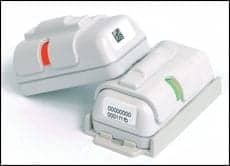 |
| Before investing in asset tracking technology, hospitals need to consider both their short- and long-term needs in order to select the most appropriate system. |
As clinical engineering tools become more mobile and computerized, asset tracking technology will continue to find its way into hospital budgets. Suppliers are optimistic about the growth potential of this relatively new market, since increasing numbers of hospitals have deployed asset tracking technology and have reported increased efficiency. The American Hospital Association’s 2006 annual technology survey1 revealed that approximately 10% of the 5,800 participants in the survey are believed to have a radio frequency identification (RFID) system in place.
Despite the growing acceptance of asset location systems, a thorough analysis of different technologies is critical in order to select one that best meets the needs of an institution. Asset tracking systems that locate items through the use of tags and receivers are most often used in conjunction with either Wi-Fi—systems that use the 802.11 bandwidth—or with proprietary RFID systems that operate on frequencies other than that utilized by 802.11. Infrared systems and ultrasound technology have also been used for asset tracking. Each of these four methods presents different advantages and disadvantages. In some cases, these technologies are combined to customize a wireless communication system.
There are also two common types of RFID systems employed in the health care industry: passive and active. Passive systems are more basic, consisting of tags that are printed instead of constructed. Although less expensive than active systems, passive systems are not capable of storing larger amounts of information in a real-time environment, which is one of the primary selling points of active systems. Before investing in asset tracking technology, hospitals need to consider both their short- and long-term needs in order to select the most appropriate system.
Located in Real Time
The University of California San Diego Medical Center Thornton Hospital in La Jolla preferred a real-time location system (RTLS) that would work with its existing Wi-Fi system. The rationale for acquiring such a system was that it could be used in the operating room to help staff quickly find equipment between cases. Tom Hamelin, RN, director of perioperative services, and his staff selected Awarepoint’s real-time awareness solution, which was eventually implemented hospitalwide to track more than 400 items across the institution’s 250,000-square-foot facility. This particular system needs no hardwiring or fixed infrastructure due to wireless sensors, which plug into electrical outlets.
“We saw value in this even before it was up and running,” says Robert Pruett, supervisor, clinical engineering, at Thornton. “Our hospital’s turnover between surgical cases is within minutes, so it’s important that operating room staff is able to locate equipment in the most efficient manner.” With this system, OR nurses can plan for their equipment needs for the next case while they are working on their electronic chart. All they do is determine which pieces of equipment they need and then pull up the Awarepoint window on their computer to find out where they are located. For example, a nurse looking for an infusion pump would call up a map of the care area that illustrates where a pump can be found. Information about each device, such as its model number, manufacturer, and in some cases its maintenance schedule, can be linked to the tag and displayed with the location.
Perhaps the best demonstration of the strength of Thornton Hospital’s RTLS system occurred last fall when wildfires raged through San Diego County. “Because of the system, we were able to quickly locate gurneys, wheelchairs, and other equipment throughout the hospital, and we knew that even if we had to enact a hospitalwide evacuation we had the wherewithal to do this smoothly,” Pruett says.
Pruett adds that in addition to helping locate equipment, the system gives nurses more time for direct patient care and reduces the wait time for patients needing transport throughout the hospital. It also enables the department’s five biomeds to manage preventive maintenance (PM) and product recall notices more efficiently. “We’re able to focus on other things, such as repairs, compared to the past, when we spent more time looking for equipment.” Pruett has not discovered any weaknesses with the equipment, including interference. “There are no dead spots that we can detect,” he says. “The areas that give us less than 100% accuracy, such as radiology, still allow us to find equipment 7 to 12 feet away.”
Wi-Fi Advantages
Charlotte, NC-based Carolinas HealthCare System (CHS), the third largest public health care system in the country, has implemented one of the most expansive health care RTLS deployments in the United States. Since the health care institution had heavily invested in wireless technology in recent years, it made sense to acquire a Wi-Fi-based system. “Our goal was to leverage our Wi-Fi where we could,” explains Clay Fisher, director of information service at CHS. “Since our deployment was targeted to cover 3 million square feet, laying separate proprietary infrastructure was not an attractive solution,” he says.
 |
| Some asset tracking tags offer room-level accuracy, helping users pinpoint the exact location of equipment. |
Its decision to utilize a Wi-Fi-based solution narrowed down the playing field. CHS considered at least five different vendors before selecting a system from Ekahau. On-site demonstrations by the company showed that its product was flexible, scalable, and accurate. Ekahau Wi-Fi-based RTLS tags—applied to about 2,000 assets at facilities throughout CHS—provide location accuracy to within 10 feet. The CHS network was configured for voice-over IP (VoIP), which Fisher believes is an important enhancement of a Wi-Fi-based RTLS system.
According to Fisher, CHS’ RTLS system has met his expectations and in some cases has even exceeded them. CHS has reduced its “time-to-find” for individual pieces of equipment from hours to less than 10 minutes. “IV pumps can be found within 5 minutes, which wasn’t the case before,” Fisher says. Results were particularly notable at CHS’ flagship hospital, Carolinas Medical Center (CMC), a 1.3 million-square-foot facility with a high degree of patient transport. Many patients are transferred with equipment from outlying facilities to CMC because of their acuity needs. “Now the clinical engineering staff is able to view all the equipment within one location to determine which pieces do not belong there,” Fisher says. “This keeps our overall asset utilization in line across our facilities, and thus our costs down.”
The system gives CHS visibility not only into the location of these assets, but also into how and when they are being used, allowing administration to better understand and manage its capital and operational expenses. With the RTLS system in place, Fisher adds that it did not take long before staffing efficiencies increased because biomeds no longer had to spend as much time searching for equipment and could focus on PM and repairs. In fact, CMC recently opened a new children’s hospital without adding additional clinical engineering staff, in part due to the efficiencies gained by the asset tracking system. “The bottom line is that you can do more with less because of this technology,” Fisher says.
Other staff can also attest to the positive results since acquiring asset tracking technology. CHS’ central sterile staff uses the system as a rounding tool to ensure that nursing is not storing all of the IV pumps in their areas. In the past, it was also difficult keeping track of balloon pumps in the cardiac catheter labs, since they frequently were moved to different floors. CHS’ administration hopes to utilize other applications available through this system. “Recent advances in the Ekahau tags and other creative solutions will enable us to address employee workflow in the not-too-distant future,” Fisher says.
Research Brings Rewards
After researching different asset tracking technologies, Southern Ohio Medical Center (SOMC), Portsmouth, Ohio, believed strongly that it needed to reach beyond its 802.11 Wi-Fi bandwidth in order to create an RFID system with active tags that would offer room-level accuracy. After narrowing down the field of vendors from six to three, SOMC selected the Radianse reveal asset tracking platform. “We wanted a proven, robust system with good references, and we didn’t want to be a beta site,” says Greg Malone, supervisor of the biomedical engineering department.
SOMC launched the system in October 2007 with a network of 363 receivers, connected to the hospital’s server via CAT-5 wire. The receivers were installed throughout the hospital, spaced about 30 feet apart. The hospital purchased 2,500 Radianse 433 MHz active RFID tags. Most of them have already been attached to assets either with an adhesive backing on the tag or with a lanyard that is attached to the leg of the medical device. The system provides room-level accuracy within 3 feet.
The original decision to acquire asset tracking technology came from administration, which recognized that it would be useful in locating medical equipment that had been recalled. “We had looked into these systems 10 years ago, but they were extremely costly back then, ranging from $900,000 to $1 million,” Malone explains. “Since the cost of these systems fell to less than half of what they were 10 years ago, it was an easy decision to move forward and purchase the technology.”
Malone, however, admits that it was a bit unnerving spending money on technology that is still evolving. “There’s no doubt it’s a risk, but at the same time if you do your research and select an appropriate system, the rewards are enormous,” he says. “We’re considered heroes by nurses, central sterile supply staff, and wheelchair couriers, because we have developed a system that saves them time in finding critical equipment.”
One of the benefits of the system SOMC selected was the ease of staff training. Employees were assigned 1-hour time slots for the training. The system was not even up and running hospitalwide when employees had already started using it to locate medical devices. “The efficiencies gained from using this system have definitely exceeded our expectations,” Malone says. “Hospitals are missing out on some great technology if they don’t go ahead and make these investments.”
A Cautious Approach
Even though a growing number of health care institutions are purchasing asset tracking systems, the technology is still in its infancy, causing some clinical/biomedical engineering and IT departments to remain cautious about these purchases.
Phil Englert, director of technology operations for the northern Kentucky office of Denver-based Catholic Health Initiatives (CHI), attended the 2008 HIMSS Conference and Exposition in February to learn more about available asset tracking technologies. Like many health care institutions across the country, CHI is currently comparing different vendor offerings but is not ready to purchase the technology. “We don’t want to put all our eggs in one basket just to find out that somebody else comes out with something new that might be more appropriate,” Englert says.
Englert believes that hospitals should not use increased employee efficiency and improved patient safety as the sole justification for acquiring these systems unless they have hard metrics to back up these areas. “There is a tantalizing paradox to all of this, because these systems have the potential to be so many things to so many different people, but I believe the technologies are still maturing.”
Carol Daus is a contributing writer for 24×7. For more information, contact .
Reference
- American Hospital Association. Continued progress: Hospital use of information technology. www.aha.org/aha/research-and-trends/AHA-policy-research/2007.html. Accessed April 14, 2008.




